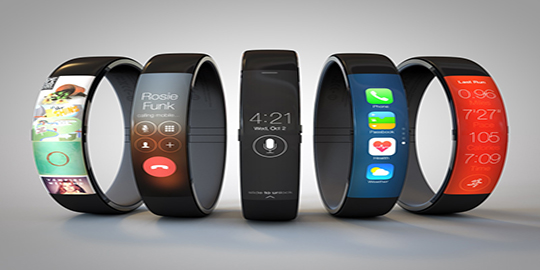
Observatorio tecnológico del 25 al 31 de agosto
This week's Technology Observatory brings you the following stories:
- Android L to be called Lemon Meringue Pie?
- WhatsApp passes 600 million active users mark
- Rumors continue about Nexus 6 or Nexus X and a late October release date
- Confirmed: Amazon to buy Twitch for 970 million dollars
- Google buys Zync Render
- Surprise: The Amazon Fire Phone is a failure
- Twitter statistics service now available to all users
- Apple to unveil a wearable with iPhone 6
- Motorola confirms 249 dollars price tag for its Moto 360
- LG circular G Watch R now official
- Surface Pro 3 now on sale in Spain with prices ranging from 799 to 1,949 euros
- Samsung launches its latest wearable, the Gear Circle necklace
- iPhone 6 to be unveiled on September 9

Ever since Google presented the preview of Android L and gave us a peek of what to expect, we've been anxiously awaiting details of the novel features and the complete name of the next Android version. To be honest, we had no evidence to back any of the possible names so it was all pure speculation. Now though, Android Police, true to form, are following a lead and if they're right, bearing in mind there's always a margin of error, Android L will be called Lemon Meringue Pie. Besides, the SDK for developers of the Nexus 5 and 7 contains a tiny insert titled “lmp-preview” that everyone seems to have overlooked until now. After conducting a survey of popular desserts, Android Police have discovered that the initials stand for Lemon Meringue Pie. What's more, a certification document for an HTC tablet has also been found to contain the initials LMP, which tightens the circle around the aforementioned name as well as the Nexus 8 or 9, made by HTC. In any case, let's not get too carried away. Last year what in theory should have been Key Pie Lime turned out to be KitKat, so between now and the release Android might well team up with another candy company. One thing we can be sure of, though, is that the code name is LMP.
We more or less knew that WhatsApp was the leading messaging platform, in spite of all the free similar options that inundate the market, especially in Asia. This week, its CEO Jan Koum* announced that they had passed the **600 million active users mark in the space of a month. The company, now owned by Facebook, made a similar announcement last April, claiming to have reached around 500 million active users. Jan's tweet contains a message for other competitors in the sense that its numbers refer to active users, not simply registered users, which in practice are two very different things. Casting an eye over the data available for other platforms, it appears that Tencent’s WeChat has around 438 million active users, all in China, while other key names like Tango and Viber boast 70 million and 100 million active users, respectively. With serious intentions of expanding to the West, WeChat is clearly the most worrisome alternative. Whether 19 billion dollars was a lot or a little to pay for WhatsApp is another debate, but the truth is that the service is in robust health, far better in fact than Facebook's own service Messenger, which has around 200 million active users. Added together, and factoring in Instagram users, these figures certainly demonstrate that the social media site has a firm control over our communications. WhatsApp has maintained its original business model, charging one euro for an annual subscription, while most of its competitors are flirting with the sale of content or games.
With the fall just around the corner, we're gearing up for the launch of the latest Nexus models, which Google usually unveils at this time of the year. Although there's no definite confirmation, countless rumors are doing the rounds about the direction Google might be taking. This time it's the turn of the phone that will replace the Nexus 5, called Shamu, which looks set to receive a completely different name and instead of Nexus 6 will be called Nexus X. The reason appears to be avoiding a lawsuit with the family of Philip K. Dick, author of the book Do Androids Dream of Electric Sheep?, which mentions a specific Android model called Nexus-6. Apart from that, there's also speculation that the release date will be late October, specifically around Halloween. Nothing has been confirmed as yet, but that date would tie in with the release dates of earlier Nexus models. For the moment, the information we have is basically what we already knew: it will have a quad-core Krait 450 CPU with a speed of 2.65 Ghz and an Adreno 420 GPU, 3 GB RAM, and a 5.2-inch QHD display (2560x 1440 pixels, same resolution as the LG G3), with a pixel density of 564 ppi. However, other rumors suggest a 5.9-inch display, which would make it closer in size to a phablet.
Following endless rumors and speculation, Amazon has confirmed the acquisition of Twitch, the successful streaming video game platform, for 970 million dollars, which means that Google has lost a golden opportunity to enhance its video service and Amazon has made a decisive entry into the world of video games. The deal seals Amazon's eagerness to secure a niche in the market where Twitch, founded only three years ago, has demonstrated that this model has a promising future and is attracting users thick and fast. In July, Twitch recorded more than 55 million users and more than 15 billion minutes of content produced by one billion users, confirming its status as the fourth busiest platform in the United States, behind only Netflix, Google and Apple. Twitch CEO Emmett Shear says they chose Amazon because of shared values and a shared vision of the future in which Twitch will retain its identity, office and current workforce, allowing the two companies to grow together and improve their position much more quickly. Accordingly, Twitch will continue to operate independently until its integration with Amazon's services is announced.
Meanwhile, the Mountain View folk have been shopping again. This time they've acquired the visual effects firm Zync Render. Zync technology makes it easier for movie studios to render their visual effects in the cloud, and has been used in mega projects like Star Trek: Into Darkness, Looper, Transformers, Flight and American Hustle. It typically takes a powerful infrastructure to render the visual effects we see in blockbuster movies. Major production companies have their own divisions for this task, but sometimes they need to increase their capacity to reduce the production time, and at times like these they look to the cloud. Small production companies rarely have the capital to finance their own rendering facility, so for them the cloud is the only way they can create visual effects at an affordable price. The company has posted an announcement celebrating the acquisition on its official website, claiming that the scale and reliability of Google Cloud Platform will enable them to service customers more efficiently. For its part, Google will harness the Zync Render technology to make it easier for movie studies to use its Cloud Platform for their creations. Currently, Zync is optimized for work on Amazon's EC2 service, but is being adapted for integration with Google's infrastructure.
It's just over a month since we greeted the arrival of the Amazon Fire Phone, the device that was supposed to put Bezos' company on the complicated mobility map. The design, featuring dynamic perspective – based on a system of front-facing cameras – and the FireFly application, was also meant to set it apart. But the device was clearly overpriced. That and the limited practicality of the aforementioned differential features have had a dramatic effect on sales. In these first few weeks since the device hit the market, Amazon has only sold an estimated 35,000 Fire Phone terminals. The figures were reported in The Guardian and based on the latest reports from consultants Comscore and Chitika. For example, the Fire Phone was only responsible for 0.2% of the online advertising activity monitored by the latter company in the United States. With an estimated 175 to 177 million smartphones currently used in the U.S., this points to the sale of around 35,000 devices in these first few weeks of availability. The Fire Phone's sole interesting feature is the introduction of FireFly, an app that lets you scan photos or barcodes of products to find out how much they cost to buy at Amazon. This capability made the Fire Phone the perfect shop assistant for Amazon's heavy users, allowing them to discover prices and specifications for products supplied by the eCommerce giant at the click of a button. The problem is that this feature shouldn't only be available in these devices: Amazon would do well to launch FireFly as an independent app for Android and iOS. In fact, neither this feature nor the front-facing cameras, of very little practical use for owners of the device, justify the price of the Fire Phone. Amazon has tried to place its device on the same par as high-end Apple or Samsung terminals, but in fact what you get is a mediocre device that just doesn't make the grade in many aspects. So now Amazon appears to be facing a crossroads: these sales are unjustifiable for a project of this magnitude, and the situation doesn't seem likely to improve in the coming months, especially when the devices from other manufacturers – many of which we'll see at IFA in a few days – will reinforce the fact that the Fire Phone simply can't compete at those prices. With such a dilemma, Amazon seems to have only one way out: drastically reducing the price of the device, lowering its expectations and profit margin, and trying to rescue a boat that seems doomed to sink to the bottom of the ocean. It's unlikely that Bezos' company will make this difficult decision: like Apple, Amazon exercises an iron grip over its ecosystem and the prices of everything it sells. The situation with the booksellers is a case in point. And yet, reducing the 649 dollars it costs for the no-contract option to a much more reasonable (it doesn't cost anything to dream) 349 dollars would surely attract a considerable number of users and allow Amazon to: 1) save its inventory and 2) continue to earn money from devices that cost around 210 dollars to make. This price reduction should be accompanied by the publication of the FireFly app "for all users", and probably by the immediate leap to a non-dynamic perspective variant on the model minus that system of front-facing cameras, which has to be the most absurd feature we've seen in a mobile device for a long time.
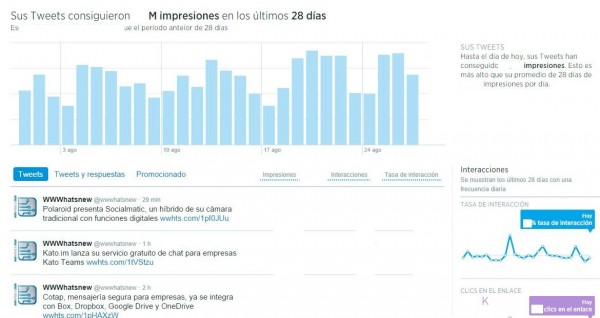
Until now, the tweet activity dashboard offered by Twitter at analytics.twitter.com was only available for celebrities, verified accounts and advertisers. Now it seems this limitation is about to be removed as an announcement in the Twitter support section states that the tool will soon be available for all users who have an account more than two weeks old and post tweets in in English, Spanish, French and Japanese. Although no dates are mentioned, it looks like some users have already managed to access the dashboard to consult the activity generated by each tweet: number of retweets, interactions, trends, etc. – in short, data to help you identify which type of content your followers find most interesting. The data can be exported to an CSV file and then imported into an information management program to obtain more complete statistics than the platform offers. A “Google Analytics” for Twitter that professionals who use this social media site will find particularly useful.
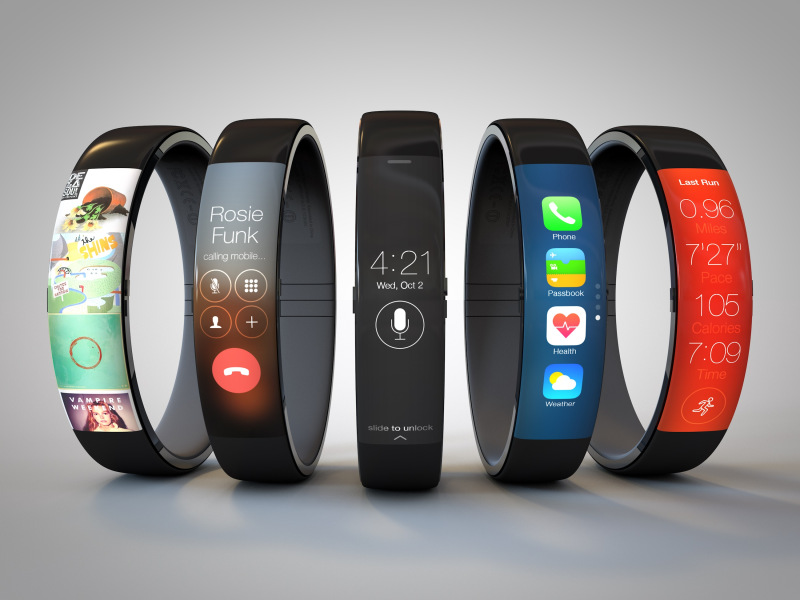
Next September 9 Apple is set to unveil its new generation of smartphones, the iPhone 6, and as usual, given that this is a star terminal destined to replace the iPhone 5s, it's likely to be an event to remember. But that's not all. According to a report from Re/code, iPhone 6 won't be the only protagonist of the event: it will be joined by the firm's first wearable device. So it looks like Apple will be unveiling a new iPhone as well as a wearable device in early September. Are we finally going to see the much-speculated-about iWatch? John Gruber, an expert analyst with sources close to Apple, thinks not. Rather, what we can expect to see is a wearable device like a smart bracelet for tracking your steps, heart rate and more, something in line with the health apps that will come with iOS 8. What is certain is that Apple could come up with anything for its incursion into the wearables market, and we can be sure it will be something different from what we've seen up to now. More importantly, it will be seamlessly synchronized with iOS 8 and the health features that Apple promoted so strenuously when they were unveiled at WWDC 2014. In fact, it would make a lot of sense to announce a wearable with the new iPhone, as the ideal companion or perfect accessory for Apple smartphone users. There's obviously a lot of curiosity about what Tim Cook and company will present at the upcoming great event, but everything suggests it will be September 9 when we see Apple's latest devices for the mobile – and wearables – market.
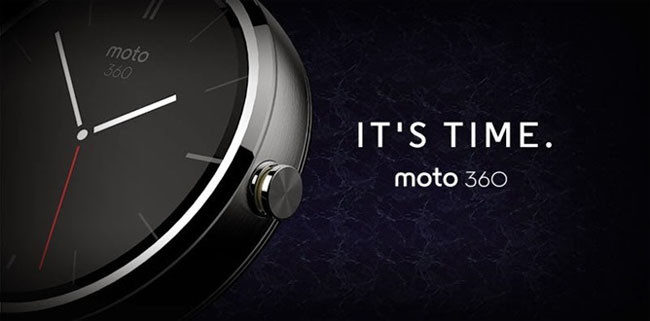
One of the mysteries surrounding the Moto 360 has just been resolved. Motorola has announced that its smart watch based on Android Wear will retail at 249 dollars, the same figure that was leaked some time ago. The company confirmed the price as part of the "Yo for Moto Giveaway" promotion just launched in the United States, in which will it literally give away 20 Moto 360 watches. The competition rules state that the prize is worth 249 dollars, so barring last-minute surprises that must be the recommended retail price: PRIZES: Twenty (20) winners will receive a Moto 360 (ARV $249). The total ARV of all available prizes in the Promotion is $4,980. In Europe it's certain to cost 249 euros, as indicated months ago. Now all we need are the specifications and release date, which we'll find out on Thursday September 4 at its official presentation alongside the Moto X+1, Moto G2 and some Bluetooth headphones.
As has become customary with LG before an important fair – in this case IFA 2014 – it tends to unveil its products one by one a few days ahead of the gathering. They had already let it slip that their next watch would be round, and they have not wasted too much time in presenting it officially. Enter the LG G Watch R, destined to compete directly with another Android Wear device, the Moto 360. The idea is to offer something that looks much more like a conventional watch, and from what we can see – we don't have the real dimensions yet – they seem to have hit the nail on the head. LG and Samsung fired the starting shot for Android Wear devices, and as the first to shoot they were always going to be ready to take the second shot. The evidence is this watch, with a design and technology far superior to those of the first product. Its retro look and premium materials are sure to attract attention, even from those waiting with blind faith for Motorola's watch. However confusing the interface and external appearance, this is an Android Wear device, with all of its features. LG Display has pulled out all the stops to create the perfect face for a smartwatch, which as you can see is circular, measures 1.3 inches and has a resolution of 320x320 pixels. The technology used is Plastic OLED. Yes, the display utilizes 100% of the watch face. In other words, there are no black areas for sensors, as in the case of the Moto 360. The display rests on a stainless steel frame and it comes with an interchangeable 22mm leather strap. LG is particularly proud of the visibility and duration of the display afforded by the Plastic OLED technology. The watch is also dust and water resistant, with IP67 certification, which means it will run for up to 30 minutes in one meter of water. As for its specifications, it’s powered by a 1.2 GHZ Snapdragon 400 chipset, which is coupled with 512MB RAM and 4 GM of internal memory. Despite the tiny space available, they've managed to insert a 410 mAh battery and have even included a heart rate sensor – not present in the first model – making it a fairly coveted accessory for people who want to use it for sports activities. This function will also be complemented by a gyroscope, accelerometer, barometer and digital compass. The LG G Watch R will receive its presentation in society at the IFA in Berlin, on September 4. We already know that initially it will be available in black and will be compatible with Android smartphones that have version 4.3 or higher. Nothing has been said about the price, but we do know that it will reach markets by the fourth quarter of this year. LG has developed its watch in record time, and it just might pip Motorola at the post.
Everything comes if you wait long enough, including Surface Pro 3. As announced by Microsoft at the beginning of August, the latest member in its family of tablets has finally reached our country and another 24 markets worldwide. All of these now join the United States, Canada and Japan, which have been using Microsoft's tablet-cum-laptop for months. Surface Pro 3 reached stores in Spain last Thursday, August 28 and prices start at 799 euros. That's the price for the basic configuration with an Intel Core i3 processor and 64 GB of internal storage. The highest price will buy you an Intel Core i7 processor and up to 512 GB of storage. Here's the complete list of options:
● Intel i3 + 64 GB: 799 euros
● Intel i5 + 128 GB: 999 euros
● Intel i5 + 256 GB: 1,299 euros
● Intel i7 + 256 GB: 1,549 euros
● Intel i7 + 512 GB: 1,949 euros
In addition to Spain, the Surface Pro 3 has just reached the stores in the main European markets, such as the United Kingdom, France, Germany and Italy, and parts of Asia and Oceania. Also available in all of these countries is the touch cover keyboard, retailing at 129.99 euros, and you can also reserve the kickstand, which will be available from September 12 for 199.99 euros.
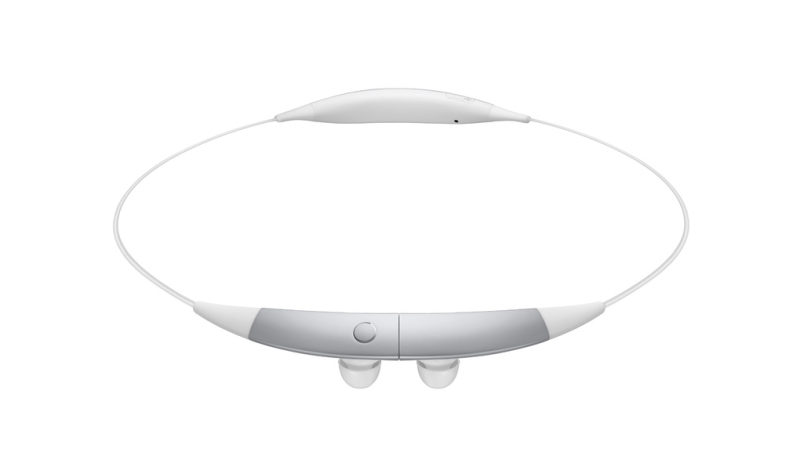
A day of multiple unveilings a few days ahead of the start of the IFA. After seeing what looks like the very attractive LG G Watch R, Samsung has unveiled its new Gear S, a wearable unlike anything it's ever presented. This one, reported in The Verge, is called Samsung Gear Circle and is a necklace. That's right, a necklace. After making smartphones an extension of our arms and tablets a must-have item in our bags and backpacks, Samsung then decided to encircle our wrists. They weren't the only ones, naturally. Ok, seems legit. Some attempts have been more successful than others, but on the whole they're not bad. There wasn't much margin for anything else – that is, until Samsung decided otherwise. Now they want us to wear a necklace – even if doesn't look much like a necklace – and listen to music through its headphones or send voice commands to our Bluetooth-connected smartphone. Oh, and it vibrates to let you know you have a notification. If you want to know what kind, just check your smartphone. The device can be worn as an item by fastening the headphones with the magnetic clasp to "look like" a necklace, round the back of your neck with the headphones in your ears, or tucked away in your pocket. Rollout starts in October and it will be available in three colors: black, blue and white.
As we all expected – in this respect the rumors about Apple usually hit the mark – Apple has now announced the date of its highlight event of the year: September 9. And as you might expect, that is when the company will unveil its new smartphone, a priori the iPhone 6. After a busy week at IFA with major launches by rival companies like Samsung and Sony, it will then be Apple's turn. In keeping with how it's worked for the last couple of years, a small amount of general information about the next smartphone from Apple has already been more or less revealed. This year it's the design prototypes, with curved edges, although what iPhone enthusiasts really want to know is whether it will be bigger. Increasing the display to at least 4.7 inches seems a given, and in all likelihood the rumors will be confirmed and they'll announce two new iPhone 6 models larger than the existing ones. The 5.5 inch display is what everyone is wondering about, but it may not be included in this year's offering. It also seems likely that NFC will be another novel feature of the model. We discussed the other possible specifications not long ago, the stand-outs being the camera and the possible use of sapphire to protect the display. All will be revealed in less than a week. Another thing people are wondering about is Apple's smartwatch, the much-vaunted iWatch. With the torrent of devices from the competition (Moto 360 or the more recent G Watch R from LG and Gear S from Samsung) and continuous rumors about the model from Apple, this is another surefire gamble. Perhaps with a new loading system or available in a variety of designs. The rumors seem to be narrowing down and it looks like the device will have more in common with a smartband than a sophisticated watch. Whatever, come September 9 we'll know for sure: iPhone 6, iWatch and perhaps one more thing. The countdown has begun.
